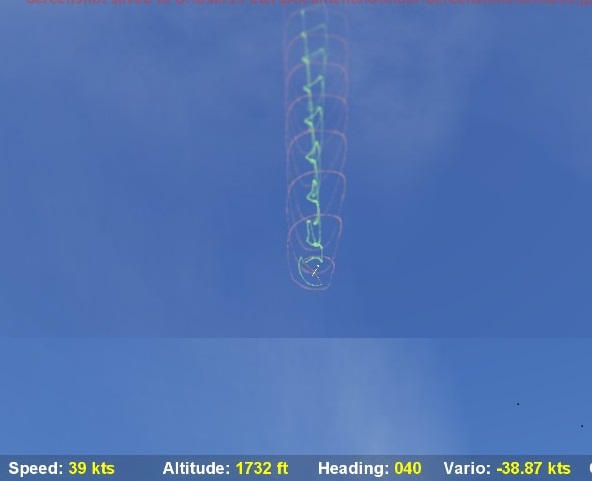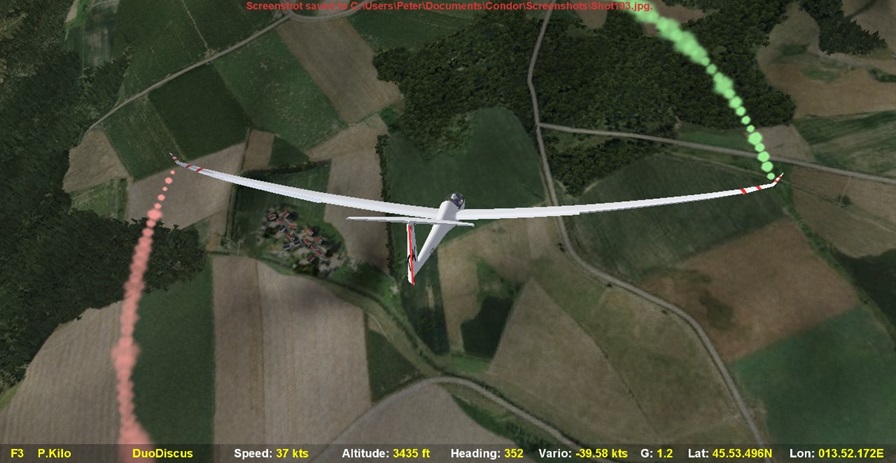I am not a certified pilot instructor. Information on these pages are published only to serve as points of discussion between you and your licensed instructor.
SPINS
A spin is when one wing is producing far less lift than the other, and the ship is rotating as it falls to the earth. In the US military we did spins routinely during pilot training in the T-37. Everyone became proficient. I have also practiced spins in light powered planes as well as gliders. Nothing to be afraid of, as long as you have enough terrain clearance.
In recent years, while sharing stick time with fellow pilots, I would often demo to a new pilot the approach to a spin – which is referred to as an incipient spin, just so they would be comfortable in recognizing behavior of that ship when flying too slow and uncoordinated. Once a pilot has been properly taught how to recover an out of control glider there is no need to actually practice doing spins. However, a periodic review of the mechanics of a spin often prove to be appreciated by many pilots.
Even without moving the center of gravity (CG) further aft than normal, you can spin most any airplane. If you have a normal CG, then the recovery is simple. If you have a very aft CG it may be a flat spin – which is more difficult to control.
Most aircraft will do a spin without damage to the ship, if, you apply proper recovery techniques. The most important factor in recovering from what you think is a spin is …. RECOGNITION.. is it a spin or a spiral? If airspeed is above stall speed ( and increasing rapidly) you are in a spiral – NOT a spin! Although you are turning and descending, you are not in fact rotating. DO NOT PULL HARDER, lest you exceed the G-limits of the glider.
Know this! If you apply spin recovery procedures while in a high speed spiral, then you will probably rip the wings off – as has been done so many, many times in the past.

This image is a screen shot I snapped while performing a spin to illustrate the “flight” pattern of the ship. Condor allows you to have smoke coming from the wing tips, which is very helpful for this discussion.
In this illustration I am flying solo in a two place Duo Discus performing a full spin. To enter the spin I mimicked a skidding turn to final while in a shallow banked turn to the right and I purposely allowed the glider to stall. The wing just dropped, as did the nose. I was in a spin in an instant. As shown on the lower edge of this screen shot, I had dropped below the stall speed of 41 kts, and airspeed was fluctuating between zero and 40 kts, with a current reading of 39 kts, and the Vario indicating the ship is descending at over 38 knots – straight down! As you can see the left wing (red smoke) is flying and inscribing circles as we (I) descend. Whereas the right wing (green smoke) is moving up and down erratically as it points somewhat downward. The good news is that I am still 1700 feet above the airport, and since I am able to perform a full recovery in three or four hundred feet, I still had plenty of altitude for a normal landing pattern, which I in fact did.
I snapped this screenshot earlier, from another viewpoint during this same spin. Here I was passing 3,400 ft, but with the same vertical rate of descending at 39 kts As shown on the previous pix. If you look closely you will see am still holding the rudder to the right, and the stick to the right, as evidenced by the left aileron being down and right aileron being up.

Neutralize the ailerons, use rudder to stop the rotation and recover from the ensuing dive. Even with a gentle pull up, I did not exceed 80 kts during the recovery from this spin.
SPIRALS
Spirals on the other hand are insidious. You may think you are in a spin because you are pointing at the ground and it appears the ship is rotating, but in fact it is only turning rapidly with the nose pointed downward. Check the airspeed! If it is increasing the first thing to do is apply aileron to stop the turn, that is, perform a coordinated turn opposite to the current turning direction. If you pull the stick back without halting the turn, you will invariably increase the g forces to the point that the wings will break off.
End